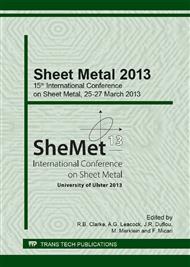p.295
p.302
p.311
p.317
p.325
p.333
p.340
p.349
p.356
Effectiveness of Stamping Lubricants in Erichsen Test
Abstract:
In the present work, formability of ultra low carbon steel sheets (uncoated interstitial free and galvanized steel sheet) has been characterized and the effectiveness of dry and liquid lubricants on formability of these steel sheets was evaluated by using the standard Erichsen test. Primarily, some important mechanical properties of materials like strain hardening coefficient (n), normal anisotropy (r) were determined using the tensile test and formability of these steel sheets has been correlated with these mechanical properties. Then these steel sheets were subjected to the Erichsen test using four different lubricants. Teflon, PVC, Polyethylene films and mineral oil were used in the experiments. Finite element simulations were done using various friction coefficients. Erichsen tests were conducted at 1 kN blank holder force and 2.4 mm/min punch velocity. Values of the Erichsen index and punch force-displacement curves were determined for each lubricant. PVC film proved to be the most effective lubricant for both materials.
Info:
Periodical:
Pages:
325-332
Citation:
Online since:
April 2013
Authors:
Price:
Сopyright:
© 2013 Trans Tech Publications Ltd. All Rights Reserved
Share:
Citation:


